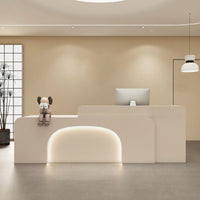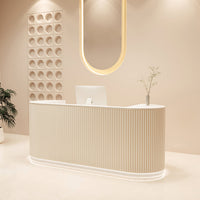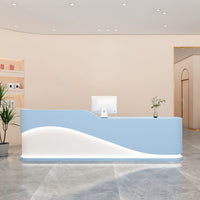How to Run a Reception Desk?
kaguyasuContent Menu
● Organization and Efficiency
>> Workspace Management
>> Document Management
● Customer Service Excellence
>> Communication Skills
>> Visitor Management
>> Handling Difficult Situations
● Technology Integration
>> Visitor Management Systems
>> Communication Systems
>> Office Equipment
● Continuous Improvement
>> Feedback Collection
>> Data Analysis
>> Process Improvement
● Sample Questions and Answers
● Citations:
The reception desk is often the first point of contact for visitors, clients, and employees, making it a crucial hub for any organization[1][5]. It is essential for creating a positive first impression and ensuring smooth operations[1][2]. Running a reception desk efficiently involves a combination of organizational skills, customer service excellence, and the effective use of technology[1][2][8]. This article provides a comprehensive guide on how to manage a reception desk effectively, covering key aspects such as organization, customer service, technology integration, and continuous improvement[1][2].

Organization and Efficiency
Maintaining a well-organized reception desk is essential for efficiency and professionalism[2][3][5]. A clutter-free workspace not only enhances productivity but also conveys a positive image to visitors[2][6].
Workspace Management
1. Decluttering: Regularly remove unnecessary items from the desk to maintain a clean and orderly appearance[3][5][6]. Use desk organizers, trays, and containers to sort and store essential items such as pens, notepads, and stationery[2].
2. Storage Solutions: Utilize storage containers, trays, and holders to keep the desk uncluttered and ensure items are easily accessible[2]. Implement wall-mounted organization accessories like cork boards, whiteboards, shelves, and magazine racks to maximize space and keep important information visible[2].
3. Ergonomics: Ensure the desk is ergonomically designed to promote the comfort and well-being of the receptionist[4]. The height and layout of the desk should be suitable for the receptionist's needs, and compatible with their chair or stool[4].
4. Essential Items: Keep essential items within easy reach, including computers, telephones, and office supplies[2]. Consider using a telephone headset to free up hands for note-taking and computer use[3].
5. Wire Management: Implement wire management solutions to keep cables hidden and prevent clutter[6]. Hooks, grommets, and under-desk storage can help maintain a tidy workspace[6].
Document Management
1. Filing System: Establish a clear and efficient filing system for both physical and digital documents[2]. Use labeled folders and drawers to organize paperwork, and regularly update and archive files as needed[2].
2. Digital Organization: Implement digital organizational systems such as electronic calendars, task management applications, and CRM tools to reduce paper clutter and simplify access to essential information[2].
3. Document Trays: Use document trays to sort incoming and outgoing paperwork, and ensure timely processing of all documents[2].
Customer Service Excellence
Providing exceptional customer service is a critical function of the reception desk[1]. Receptionists are often the first point of contact for visitors, and their interactions can significantly impact the visitor's perception of the organization[1].
Communication Skills
1. Professional Demeanor: Maintain a professional and friendly demeanor at all times[1]. Greet visitors with a smile and offer assistance promptly[1].
2. Effective Communication: Communicate clearly and concisely, both in person and over the phone[1]. Use polite and professional language, and actively listen to the needs and concerns of visitors[1].
3. Telephone Etiquette: Answer phone calls promptly and professionally, using a standardized greeting[1]. Take accurate messages and ensure they are delivered to the intended recipient in a timely manner[2].
Visitor Management
1. Welcoming Environment: Create a welcoming and professional reception area with comfortable seating, good lighting, and tasteful decor[1]. Ensure the space is clean, tidy, and free of clutter[1][5].
2. Visitor Policies: Establish clear visitor policies and procedures to ensure a consistent and secure environment[1]. Communicate these policies to all employees and visitors, and enforce them fairly and consistently[1].
3. Check-In/Check-Out Process: Implement an efficient and automated check-in/check-out process for visitors[1]. Use visitor management software to streamline the process, minimize errors, and reduce the workload of reception staff[1].
4. Security Measures: Implement security measures to protect the safety and security of employees and visitors[1]. This may include security cameras, access control systems, and visitor badges[1].
Handling Difficult Situations
1. Conflict Resolution: Develop skills in conflict resolution to effectively manage difficult or confrontational visitors[1]. Remain calm and professional, listen to their concerns, and attempt to find a mutually satisfactory resolution[1].
2. Problem Solving: Be prepared to handle a variety of issues and requests, and empowered to make decisions and find solutions[8]. Escalate complex issues to the appropriate personnel as needed[8].
3. Emergency Procedures: Be familiar with emergency procedures and protocols, and able to respond quickly and effectively in the event of an emergency[1].
Technology Integration
Leveraging technology can significantly enhance the efficiency and effectiveness of a reception desk[1]. Implementing the right tools and systems can streamline operations, improve communication, and enhance the visitor experience[1][2].
Visitor Management Systems
1. Automation: Implement visitor management software to automate the check-in/check-out process, track visitor time, and ensure accurate data logging[1].
2. Data Collection: Utilize the system to collect data on visitor demographics, preferences, and visit history[8]. This information can be used to improve customer service and tailor the visitor experience[8].
3. Integration: Integrate the visitor management system with other business systems, such as CRM and security systems, to streamline operations and improve data accuracy[8].
Communication Systems
1. Telephone System: Utilize a modern telephone system with features such as call forwarding, voicemail, and caller ID[3]. Ensure the system is properly maintained and that reception staff are trained on its use[3].
2. Intercom System: Implement an intercom system to facilitate communication with other staff members and departments[3].
3. Email and Instant Messaging: Use email and instant messaging for internal communication and for communicating with visitors and clients[2].
Office Equipment
1. Photocopier/Scanner: Ensure a reliable photocopier/scanner is readily available for copying documents, licenses and other information[3].
2. Printer: Have a printer available for printing documents, labels, and visitor badges[2].
3. Computer and Software: Utilize a computer with appropriate software for managing appointments, contacts, and other tasks[2].
Continuous Improvement
Continuously evaluating and improving reception processes is essential for maintaining efficiency and delivering excellent customer service[1]. Regularly solicit feedback from employees and visitors, and use this feedback to identify areas for improvement[1][8].
Feedback Collection
1. Employee Feedback: Regularly solicit feedback from reception staff on their experiences, challenges, and suggestions for improvement[1][8].
2. Visitor Feedback: Collect feedback from visitors through surveys, feedback forms, or informal conversations[1][8]. Ask about their experience at the reception desk, their satisfaction with the service provided, and any suggestions they may have for improvement[1].
Data Analysis
1. Analyze Data: Analyze the data collected from feedback and other sources to identify trends, patterns, and areas for improvement[1][8].
2. Identify Issues: Use the data to identify specific issues or problems that need to be addressed, such as long wait times, inefficient processes, or communication breakdowns[1][8].
Process Improvement
1. Implement Changes: Based on the data analysis, implement changes to improve reception processes, policies, and procedures[1].
2. Training and Development: Provide ongoing training and development opportunities for reception staff to enhance their skills and knowledge[1].
3. Stay Updated: Keep up with technological advancements and industry best practices for visitor management and customer service[1].

Sample Questions and Answers
1. Question: What are the key elements of a well-organized reception desk?
Answer: The key elements include a clutter-free workspace, efficient filing systems, accessible storage solutions, and ergonomic design[2][4].
2. Question: How can a receptionist create a welcoming environment for visitors?
Answer: A receptionist can create a welcoming environment by maintaining a professional demeanor, offering prompt assistance, and ensuring the reception area is clean, comfortable, and inviting[1][7].
3. Question: What technologies can be used to improve reception desk efficiency?
Answer: Technologies such as visitor management systems, modern telephone systems, intercom systems, and digital organizational tools can significantly improve efficiency[1][2].
4. Question: How should a receptionist handle difficult or confrontational visitors?
Answer: A receptionist should remain calm and professional, listen to the visitor's concerns, and attempt to find a mutually satisfactory resolution. If necessary, they should escalate the issue to the appropriate personnel[1].
5. Question: What are some best practices for continuous improvement of reception processes?
Answer: Best practices include regularly collecting feedback from employees and visitors, analyzing data to identify areas for improvement, implementing changes based on the data analysis, and providing ongoing training and development for reception staff[1][8].
Citations:
[1] https://www.yarooms.com/blog/reception-management
[2] https://archicfurniture.com/blogs/furniture/reception-desk-organization
[3] https://mdmanagementgroup.com/best-practices-front-desk/
[4] https://learningcentre.officeinteriors.ca/blog/reception-desk-101
[5] https://www.visipoint.net/blog/8-office-etiquette-tips-reception-area/
[6] https://brc.group/how-to-make-your-reception-desk-stand-out/
[7] https://boofurniture.com/how-to-set-up-my-reception-area-%F0%9F%A5%87-san-diego-reception-desks/
[8] https://roomkeypms.com/blog/4-tips-keep-front-desk-running-smoothly/
[9] https://www.reddit.com/r/MicrosoftTeams/comments/166bv2s/best_practice_for_reception_desk/
[10] https://www.askcody.com/blog/visitor-management-solution-for-common-front-desk-problems
[11] https://www.welcomeware.live/front-desk-training-best-practices-you-need-to-know/
[12] https://duve.com/how-to-improve-front-desk-operations/
[13] https://m2-retail.com/blogs/news/tips-for-keeping-your-reception-desk-organized-and-efficient
[14] https://www.youtube.com/watch?v=3lIdrlZRi90
[15] https://www.linkedin.com/advice/0/how-can-you-manage-busy-reception-area-effectively-taxjc
[16] https://www.webpt.com/blog/3-big-tips-for-running-a-more-organized-front-desk
[17] https://www.numa.com/blog/how-to-manage-busy-reception-area
[18] https://www.greetly.com/blog/office-etiquette-tips





















